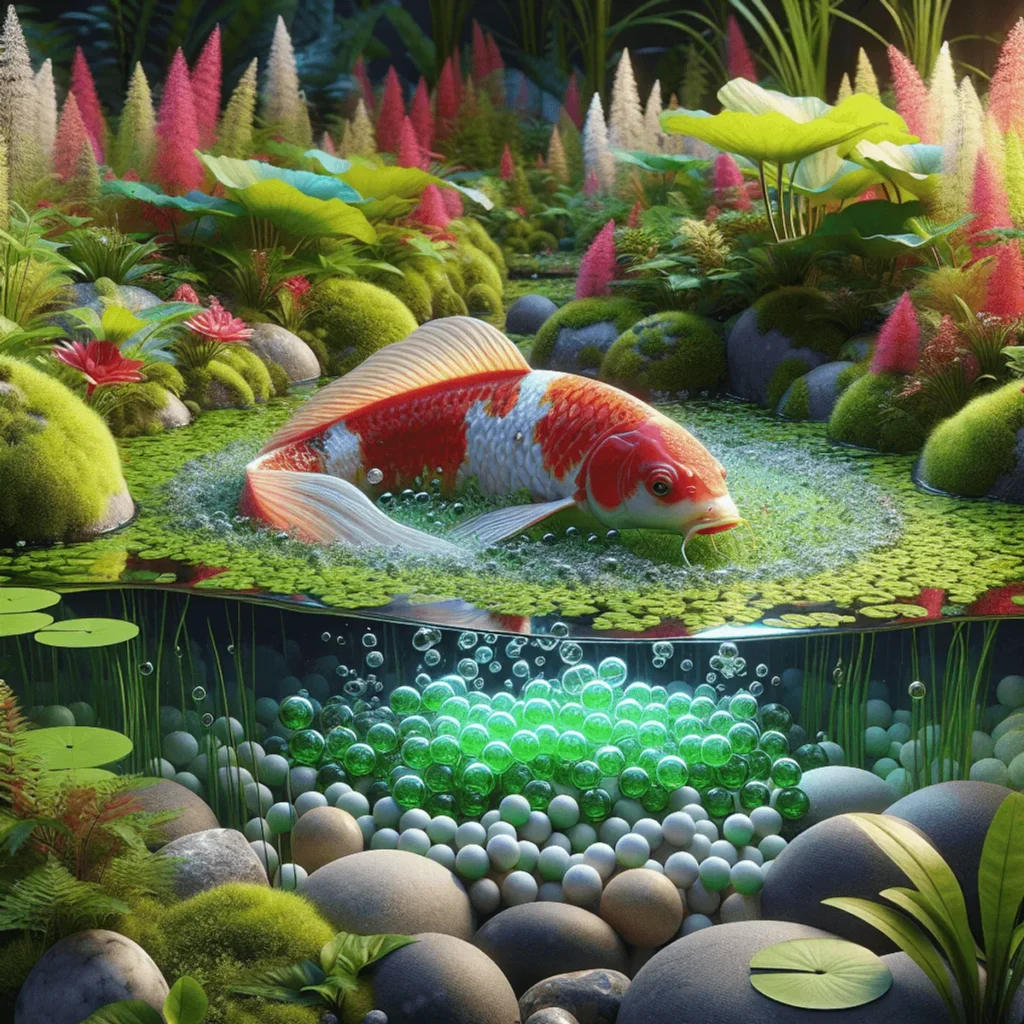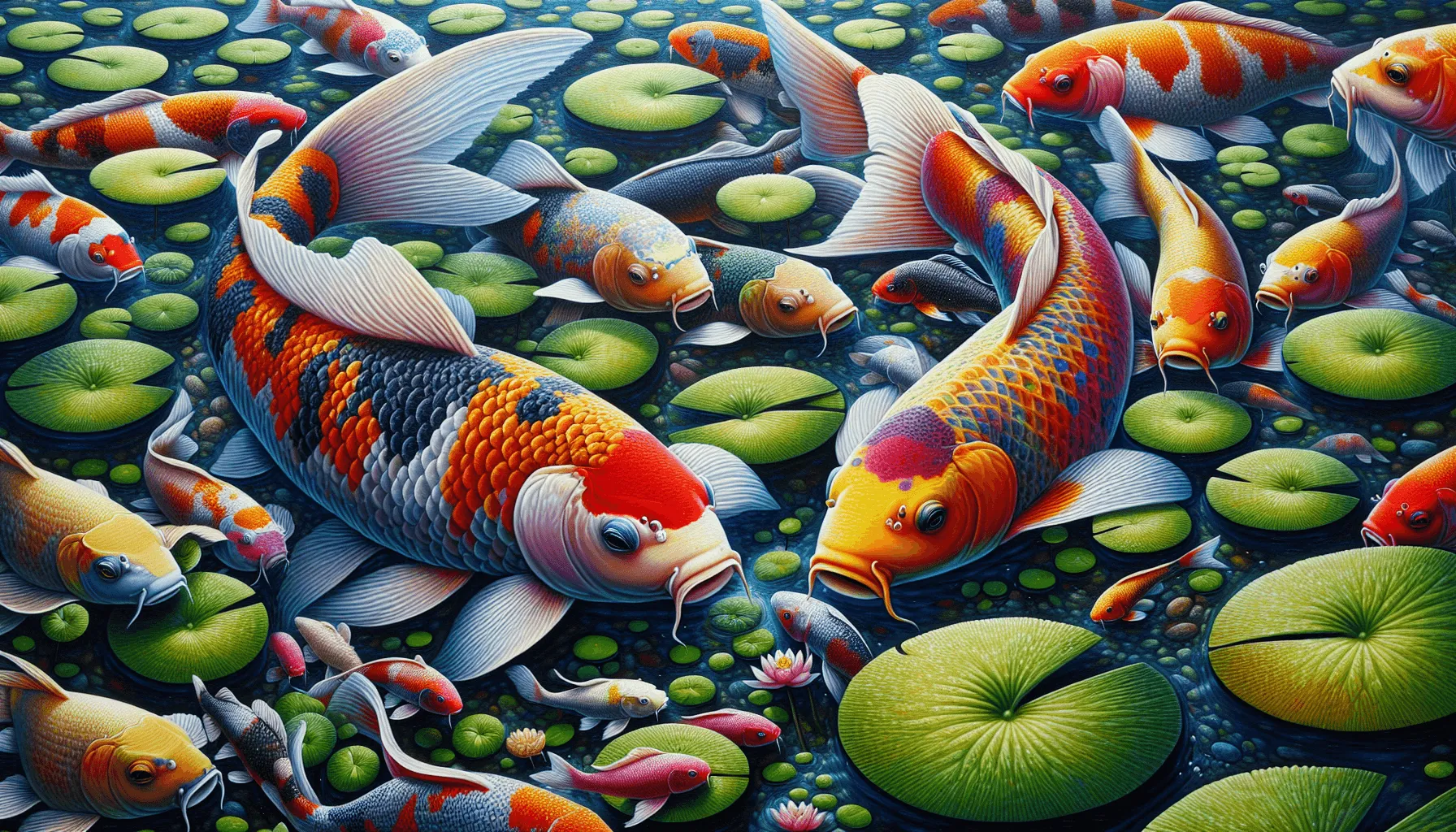Koi fish, known for their bright colors and graceful movements, are a favorite among pond lovers. These decorative fish are loved not just for their beauty but also for their interesting breeding habits. In spring, koi fish engage in elaborate courtship behaviors.
Knowing how many eggs a koi fish lays is important for both breeders and hobbyists. A healthy female koi can produce between 50,000 to 100,000 eggs per spawning cycle. Sometimes, larger koi may lay up to 400,000 eggs or more. Understanding these numbers is key to effectively planning and managing breeding programs, ensuring the health and sustainability of your koi population.
By learning more about how koi reproduce, you can better understand the complexities of breeding these amazing fish and take steps to keep your pond environment healthy and thriving.
Understanding Koi Fish Reproduction
Koi breeding involves distinct roles for male and female koi. The female koi is responsible for egg production, while the male koi fertilizes these eggs during the spawning process.
Sexual Maturity in Koi Fish
Koi usually become sexually mature around two years old. At this point, they can take part in the breeding process. Signs that they are mature include:
- Getting bigger
- Brighter colors
- Behaviors showing they are ready to breed
Factors Affecting Koi Reproduction
Several factors influence successful koi reproduction:
- Health and Size: Larger and healthier koi tend to produce more eggs.
- Water Temperature: Ideal temperatures range from 65°F to 75°F.
- Environmental Conditions: The presence of shallow areas and vegetation promotes spawning activities.
Understanding these aspects of koi reproduction helps in managing a healthy breeding environment and predicting the number of eggs a female koi might lay during the spawning season.
The Koi Mating Process
Koi fish have specific behaviors they show during mating. Male koi often chase the females around the pond, nudging them to encourage the release of eggs. This behavior can be quite vigorous, with males frequently bumping and rubbing against females.
Signs of Mating Readiness
Female Koi
A female ready to spawn may appear rounder due to the swelling of her abdomen with eggs. She might also become more sluggish and allow males to nudge her without resisting.
Male Koi
Males develop small white growths known as tubercles on their gill covers and pectoral fins. These tubercles are a clear sign that a male is ready for breeding.
Environmental Factors Influencing Mating
Optimal environmental conditions play a crucial role in successful koi mating:
- Water Temperature: Ideal temperatures range between 65°F and 75°F (18°C – 24°C). Warmer waters often trigger spawning behavior.
- Light Conditions: Longer daylight hours can stimulate reproductive activities.
- Vegetation and Shallow Areas: Vegetation provides surfaces where females can deposit eggs, enhancing the chances of fertilization.
Understanding these behaviors and conditions helps create an environment conducive to successful breeding, ensuring healthy egg production and fertilization.
How Many Eggs Do Koi Fish Lay?

Understanding how many eggs koi fish lay is essential for anyone involved in koi breeding. A healthy female koi typically lays between 50,000 to 100,000 eggs per spawning cycle. This number can vary significantly based on the size and health of the individual fish.
Factors Influencing Egg Count
Several factors influence the number of eggs a koi fish can lay:
- Size of the Fish: Larger koi tend to produce more eggs. Healthy, well-nourished larger koi have been known to lay up to 400,000 eggs in exceptional cases.
- Health and Condition: The overall health and condition of the female koi play a crucial role. Well-maintained koi in optimal conditions are more prolific in egg production.
Exceptional Cases
In some instances, large and exceptionally healthy koi can exceed typical egg counts. These extraordinary females demonstrate the upper limits of what is possible under ideal conditions.
Egg Production Summary
- Average Female Koi: 50,000 to 100,000 eggs
- Large and Healthy Koi: Up to 400,000 eggs
The sheer volume of eggs laid emphasizes the importance of providing optimal conditions for both the adult koi and their offspring.
By recognizing these key points, you can better prepare for the spawning season and ensure your koi fish are in the best possible condition for reproduction.
Koi Egg Appearance and Characteristics
Understanding the appearance of koi eggs is crucial for identifying fertilized eggs and ensuring their proper care. Fertilized koi eggs are typically small, round, and sticky, allowing them to adhere to surfaces such as plants or pond liners.
Description of Fertilized Koi Eggs
- Size: Fertilized koi eggs are usually about 1 to 1.5 millimeters in diameter.
- Shape: They are generally spherical in shape.
- Stickiness: This stickiness helps them attach securely to surfaces in the pond, reducing the risk of being swept away by water currents.
Color and Texture Variations
The color and texture of koi eggs can vary depending on the breed and health of the parent fish:
Color
- Freshly laid eggs often appear translucent or slightly yellowish.
- As they develop, fertilized eggs may turn a pale green or amber shade due to algae growth or other environmental factors.
Texture
- Initially smooth and gelatinous.
- Over time, the texture might change slightly as the embryos develop inside.
These characteristics help you distinguish between fertilized and unfertilized eggs. Unfertilized eggs often become opaque white and may develop a fuzzy appearance due to fungal growth.
Recognizing these traits aids in providing optimal care for koi eggs, ensuring higher survival rates and healthier fry.
Optimal Spawning Conditions for Koi Fish
Creating the perfect environment is crucial for successful koi spawning. Several factors play a role in achieving optimal conditions for koi reproduction.
Ideal Water Temperature
Water temperature significantly influences koi spawning activities. The ideal range is between 65°F to 75°F (18°C to 24°C). Within this range, koi are most likely to engage in breeding behaviors. Temperatures outside this range can hinder the process or delay spawning altogether.
Environmental Factors Promoting Successful Spawning
Several environmental factors contribute to successful spawning seasons:
- Water Quality: Clean, well-oxygenated water is essential. Regular water changes and proper filtration help maintain optimal water conditions.
- Lighting: Adequate sunlight or artificial lighting mimicking natural daylight cycles encourages breeding.
- Food Supply: A nutritious diet rich in protein supports the energy needs of spawning koi.
Significance of Shallow Areas and Vegetation
Shallow areas and vegetation play a pivotal role in koi spawning:
- Shallow Regions: Koi prefer laying eggs in shallow waters, typically less than 2 feet deep. These areas provide safety from predators.
- Vegetation: Plants and algae offer surfaces for egg attachment, preventing them from being swept away by currents. They also provide cover for fry, enhancing their survival chances.
Maintaining these optimal spawning conditions increases the likelihood of a successful breeding season, leading to healthier and more abundant offspring.
Timing and Frequency of Spawning in Koi Fish

Koi fish typically spawn in the spring when water temperatures rise, creating optimal conditions for egg laying. The ideal temperature range for spawning activities is between 68°F and 74°F (20°C to 23°C). During this period, you’ll notice increased activity among your koi as males begin to court females.
Frequency of Spawning Cycles
Koi fish generally exhibit an annual spawning cycle, meaning they spawn once a year. However, under exceptional conditions with ideal water quality and ample food supply, some koi may spawn biannually.
Factors influencing spawning frequency include:
- Water Quality: Pristine water conditions can encourage more frequent spawning.
- Nutritional Status: Well-fed koi are more likely to undergo multiple spawning cycles.
- Stress Levels: Low-stress environments promote healthier reproductive habits.
Understanding the spawning frequency helps you plan for breeding seasons and manage the pond environment effectively.
Egg Fertilization in Koi Fish
Egg fertilization in koi fish is a critical stage in the reproduction process. Once the female koi releases her eggs, the male koi immediately steps in to fertilize them.
The Fertilization Process After Egg Release
- The female koi lays her eggs on surfaces like pond vegetation or spawning mats.
- Male koi then release their sperm over these eggs, ensuring they are externally fertilized.
Role of Male Koi During Fertilization
- Males play an active role by nudging females to stimulate egg release.
- They follow closely behind the females, ready to release sperm as soon as eggs are deposited.
- Multiple males may compete to fertilize the same batch of eggs, increasing genetic diversity.
Challenges Faced During Fertilization
- Environmental factors such as water quality and temperature can affect sperm viability.
- Eggs are often at risk from being eaten by other fish, including adult koi.
- Poor water conditions can lead to fungal infections on eggs, reducing their chances of hatching.
Understanding these aspects of egg fertilization helps in creating optimal conditions for successful breeding and higher survival rates among koi fry.
Caring for Koi Eggs and Fry (Baby Koi)
Taking care of koi eggs and fry is crucial to ensure a high survival rate. Here are some essential tips:
Koi Egg Care
1. Separate the Eggs
Once the eggs are laid, it is important to separate them from the adult koi to prevent them from being eaten. Use a breeding net or move the eggs to a dedicated hatching tank.
2. Maintain Optimal Water Conditions
Water quality is vital. Keep the water clean and well-aerated. The ideal temperature for hatching ranges between 68°F and 72°F.
3. Monitor for Fungus
Fungus can quickly spread among koi eggs. Treat the water with an antifungal treatment like methylene blue if you notice any signs of fungal infection.
Caring for Baby Koi (Fry)
Once the eggs hatch, caring for the baby koi (fry) involves several key factors that influence their survival rates:
1. Feeding
Start feeding fry with small, high-protein foods such as brine shrimp or commercially available fry food. Gradually introduce larger food as they grow.
2. Water Changes
Regular water changes help maintain water quality. Be gentle to avoid stressing the delicate fry.
3. Shelter and Protection
Provide plenty of hiding spaces using aquatic plants or specially designed fry shelters. This helps reduce stress and provides protection from potential threats.
Ensuring these conditions will promote healthy growth and development in your baby koi, setting a strong foundation for their future in your pond or tank.
For more detailed information on caring for koi fish, including frequently asked questions, you can refer to resources provided by experienced koi enthusiasts and professionals.
Environmental Considerations for Fry Survival in Koi Fish Care
Maintaining optimal water parameters is crucial for fry development. Water conditions for fry survival include:
- Temperature: Ideally, water temperatures should range between 68°F to 77°F (20°C to 25°C). Consistent temperatures within this range promote healthy growth.
- pH Levels: A stable pH level between 6.8 and 8.2 is optimal. Sudden fluctuations can stress the fry, leading to increased mortality rates.
- Oxygen Levels: High dissolved oxygen levels are essential. Aeration through air pumps or water movement helps maintain adequate oxygen.
Common threats to fry in a pond environment often come from:
- Predators: Other fish, birds, and insects can pose significant risks to fry. Using netting or creating safe zones with dense vegetation can offer protection.
- Poor Water Quality: Accumulation of waste products like ammonia and nitrites can be lethal. Regular water testing and filtration systems help maintain clean water.
- Competition: Overcrowding can lead to competition for food and space, stunting growth and increasing stress levels. Providing ample space and resources is vital.
Understanding how many eggs a koi fish lays underscores the importance of these environmental considerations. With potentially thousands of eggs hatching at once, ensuring optimal conditions becomes even more critical to support the survival and growth of the fry.
Conclusion
Understanding koi spawning habits is crucial for any koi keeper. Knowing how many eggs a koi fish lays helps in preparing the right environment for successful breeding and fry survival.
Key points to remember:
- Caring for breeding pairs: Ensure both male and female koi are healthy and in optimal conditions.
- Monitoring water parameters: Maintain clean water, stable temperatures, and proper oxygen levels.
- Protecting offspring: Use nets or barriers to shield eggs and fry from predators.
Investing time in understanding these aspects can lead to a thriving koi population in your pond.
FAQs (Frequently Asked Questions)
How many eggs does a koi fish typically lay?
A healthy female koi fish can lay an average of 100,000 to 200,000 eggs during a spawning season, although exceptional cases have been reported where larger koi can lay up to 400,000 eggs.
What factors influence koi fish reproduction?
Factors affecting koi reproduction include the size and health of the fish, environmental conditions such as water temperature, and the presence of suitable spawning areas with vegetation.
What does the mating process for koi fish involve?
The mating process involves courtship behavior where male koi display signs of readiness to mate. Female koi exhibit specific behaviors that indicate they are ready to spawn, influenced by environmental factors like water temperature.
What do fertilized koi eggs look like?
Fertilized koi eggs are typically sticky and vary in color and texture depending on the breed of the koi. They usually appear transparent or slightly milky when first laid.
What are optimal conditions for spawning in koi fish?
Optimal spawning conditions for koi include maintaining a water temperature between 68°F to 74°F (20°C to 23°C), providing shallow areas with vegetation, and ensuring good water quality to promote successful spawning activities.
How can I care for newly laid koi eggs and fry?
Essential care tips for newly laid eggs include maintaining stable water conditions, protecting them from predators, and ensuring proper aeration. Fry survival rates can be affected by water quality and food availability after hatching.




